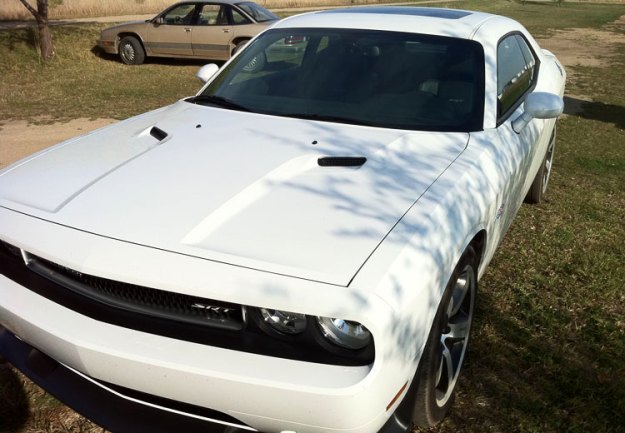
Meat and brawn, physical dexterity, the chops to take you down in one swift move. No, we’re not talking about Vin Diesel from the Fast and Furious movies. The 2011 Dodge Challenger is out for serious blood against similar muscle cars from Detroit like the Ford Mustang and Chevy Camaro.
Driving an all-white V8 model for a week, we found a few perks that impressed us beyond what even the Mustang 302 and Camaro SS offer (we’ve tested both souped-up versions of those cars in the past six months, including closed-track tests). The Challenger’s styling is arguably more of a throwback to the days when Starsky and Hutch were household names, but still sports fun digital perks, like in-car options for measuring braking distance calculator and a 0-to-60 timer.
That said, the Challenger has some tough competition that’s priced a hair lower. The 470-horsepower V8 Hemi model we tested costs $44,000, but even the base version with a V6 costs $24,895. Meanwhile, the base model Ford Mustang, which still has a 305-horsepower V6 engine, costs $22,310. The 2012 Camaro Coupe costs $23,200. Dodge, you have your work cut out for you convincing us.

One early point of victory for the Challenger: we definitely prefer the starting block punch. In testing the Challenger V8 against the 302 and SS, the Dodge has some immediate urgency. There’s a real thrill in punching the sport mode button, squealing the tires, and gobbling up open roadway. In our tests, we achieved a best time of 4.6 seconds using the paddle shifters in sport mode with the traction control disabled. In the quarter mile, we hit 13.28 seconds at the flag, and ran the eighth-mile in 8.80 seconds. Those times are a bit under the rated specs that are just milliseconds lower. (Times are often dependent on the tires you use, the road you’re on, and the person doing the driving.)
The reason the Challenger felt more muscular off the block is that it has a 470-horsepower engine that delivers 470 lb-ft of torque, compared to the Camaro SS (420 lb-ft) and the Boss 302 (380 lb-ft). The Challenger has a lurching, burly drive – you feel every piston. This is not a German racing machine, so the gears shifts are more pronounced and even a bit jarring. Cornering on the Challenger is meant to be boxy and road-heavy in a good way, not at all like a Corvette that glides around curves.
Another major difference with the Challenger compared to the Mustang and Camaro: The styling is more like what you might remember from the 70s. There’s a decidedly classic-looking front end, with a smooth angular slope toward the back. Fortunately, even with this more reminiscent look, it was easy to see out of the Challenger, and we had plenty of headroom even with the sunroof door closed.

Our test model came equipped with a powerful 900-watt amplifier and a Boston Acoustics 18-speaker stereo system. With that much audio power, you can crank up the subwoofer to a point where the whole car shakes with each beat. Unfortunately, the audio quality was not great – the stereo lacked the distinct tones of luxury cars like the Audi A8, where you can pick up specific parts of a song. Instead, you get volume and a bit too much distortion. We ended up thinking most of the music we played had power but lacked tonal distinction.
Our test car was also outfitted with a performance suspension. At $44,000, all of the trimmings put it in a class where we had to compare the Challenger directly with other performance cars, including the Boss 302 and the Camaro SS. We ended up preferring those cars, but for entirely different reasons. The Camaro has a hungrier growl, especially in idle and also when you rip into the upper gears. On a lonely country road, we the Camaro SS punched through third and fourth gear with more power.
The Boss 302 is a racing machine that’s (barely) street legal. We remember careening around corners at insanely high speeds and noting that the car barely flinched. The Challenger may be outfitted with a racing suspension, but in our experience the car felt a bit unsure on tight corners. That means, against the Boss, you might get to the first marker before anyone else, but you’ll lose on the first corner.

For fuel economy, the Challenger guzzles gas, but not quite as much as we expected. The 22MPG highway rating for the V8 is respectable, but around town we noted a 16MPG rating that meant we had to fill up twice in one week. The base-level Mustang gets 31MPG and the 302 gets 23MPG. The base level Camaro gets 30MPG, and the SS gets around 24MPG.
The Challenger is quite tight in the rear seats – passengers complained during a test drive almost constantly. There were a few other gripes as well: the trunk is unusually heavy, so kids who tried to open it had to struggle. We also had some trouble with music playback – an iPhone 4 stopped working with the stereo on one trip and we had to turn the car off, sit for a bit, and power on again.
When the Challenger just doesn’t perform as well as its Ford or Chevy competitors but costs more, you might wonder – who is the target market? For starters, it’s anyone who appreciates the classic design. Maybe it’s a car you even drove back in the day. A second prime customer: those who want to use the measurement tools, which are located right near the speedometer. We had a blast using them to test 0-to-60 acceleration, braking distance, and a quarter mile test. And there is the raw engine spec. The Challenger has more power and more torque, and if you want to make a statement in your neighborhood about who has the most muscle, this is the muscle car for you.


